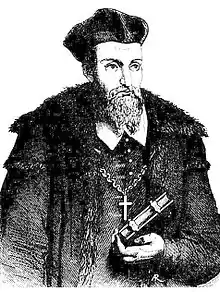Marcin Białobrzeski
Marcin Białobrzeski (1530–1586)[1] was a 16th-century Polish bishop, bibliophile, author, theologian, and preacher. Białobrzeski was born in 1530 in Białobrzegi (modern-day Tomaszów Mazowiecki) into the Abdank Noble Family.[2][3]

Career
Church career
He took religious vows in the Cistercian Monastery of Sulejów and was educated at the expense of the monastery in the Krakow Academy of Literature.[4][5][6][7]
He was a relative of Andrzej Spot. After Spot's death in 1559, Białobrzeski was elected abbot, and in 1565 or 1566, he was appointed Suffragan bishop at Krakow, as well as Titular Bishop of Laodicea in Phrygia. In 1571, he joined the cathedral chapter. On 19 July 1577, Bialobrzeski was appointed Bishop of Kamyanets-Podilskyi (Kamieniec), Ukraine.
On 7 April 1576, he greeted Stefan Batory at Mogiła Abbey. Shortly afterwards he was installed to the see of Kamieniec-Podolsk. Along with Lukasz Podolski, a canon of Kraków Cathedral, he participated in the 1557 Synod in Northern Poland, and a year later in the Synod in Jędrzejów.
Political and diplomatic roles
He was a representative of the clergy in 1573 at the Sejm (parliament), and after the coronation of Henry of Valois as King of Poland on 13 February 1574, he delivered an oration at the funeral of Sigismund August. After the escape of Henry Valois from Poland, he sided with the Habsburgs. In March 1576, Białobrzeski went with Krzysztof Lanckoroński to Vienna to an embassy of Emperor Maximilian to tell him about the newly elected King, Stefan Bathory.
In 1580, Białobrzeski went to Rome on a diplomatic mission and he served as the King's representative at the funeral of his brother, Christopher Báthory. At the 1585 Sejm, he was part of the faction defending the execution of the nobleman Samuel Zborowski in the previous year.
Death
Marcin Białobrzeski died on 19 April 1586 in Kraków, where he was buried.
Literary works
Białobrzeski was a Renaissance humanist. He is considered to be the author of 19 works, including the first Catholic homily in Polish and several books about comparative religion. He left several entries in the margins of books. His works include:
- Katechizm albo wizerunek prawej wiary chrześciańskiej ("The Catechism or image of the right faith"), Kraków, 1567
- Kazanie na pogrzebie świętej pamięci zacnego Zygmunta Augusta ("Eulogy at the funeral to the holy memory of worthy Sigismund Augustus"), Kraków: S. Szarffenberger, 1574
- Orthodox confessio de Uno Dem Christiani catholic credit, adorant et invocant, ex S. Literis description, Kraków: A. Piotrkowczyk, 1577
- Kazanie... o przyjmowaniu Ciała i Krwie P. Jezusa Chrystusa pod jedną osobą ("Sermon about taking the body and blood of Jesus Christ as one substance"), Kraków: A. Piotrkowczyk, 1579
- Postilla orthodoxa: to jest wykład Świętych Ewangielii niedzielnych i świąt uroczystych przez cały rok, (Orthodox postilla: sacred and ceremonial sermons on the gospels of feasts throughout the year); cz. 1–2, Cracow: Łazarzow, 1581
- Wierszowane dialogi o Tobiaszu i o Jobie (About Tobias and Job)
- Książeczka o religii i potężnych czynach Turków ("Book about religion and the mighty deeds of the Turks")
- Letter to Andreas Dudith, 27 February 1575[8]
- Letters to the Pope, 1583[9]
Gallery
 Marcin Białobrzeski
Marcin Białobrzeski Nagrobek Marcina Białobrzeskiego, opactwo oo. cystersów w Mogile
Nagrobek Marcina Białobrzeskiego, opactwo oo. cystersów w Mogile
References
- Cheney, David M. "Bishop Marcin Białobrzeski [Catholic-Hierarchy]". www.Catholic-Hierarch.org. Retrieved 10 February 2021.
- Nowa Huta Mniej Znana.
- Reprezentowanie króla i Kościoła na XVI wiecznych sejmach koronnych
- Bibliografia Literatury Polskiej – Nowy Korbut, Vol. 2. Piśmiennictwo Staropolskie, Państwowy Instytut Wydawniczy, Warszawa 1964, pp. 23–24.
- W. Budka, Białobrzeski Marcin, Polski Słownik Biograficzny; Vol. 1, Warszawa 1935.
- Maksymilian Rode, Mała Encyklopedia Teologiczna; Vol. I, Warszawa 1988, p. 224.
- Jarosław Pązik, Andrzej Wróbel, Białobrzegi 1405–1977, Tomaszów Mazowiecki 2005
- " Materials for the history of Polish literature"; 1, Warsaw, 1900, p. 182.
- Savio, Pietro, ed. De actis nuntiaturae Poloniae quae partem Archivi secretariatus status constituunt, Città del Vaticano 1947, (Studja teologiczne; XIII); p. 105.